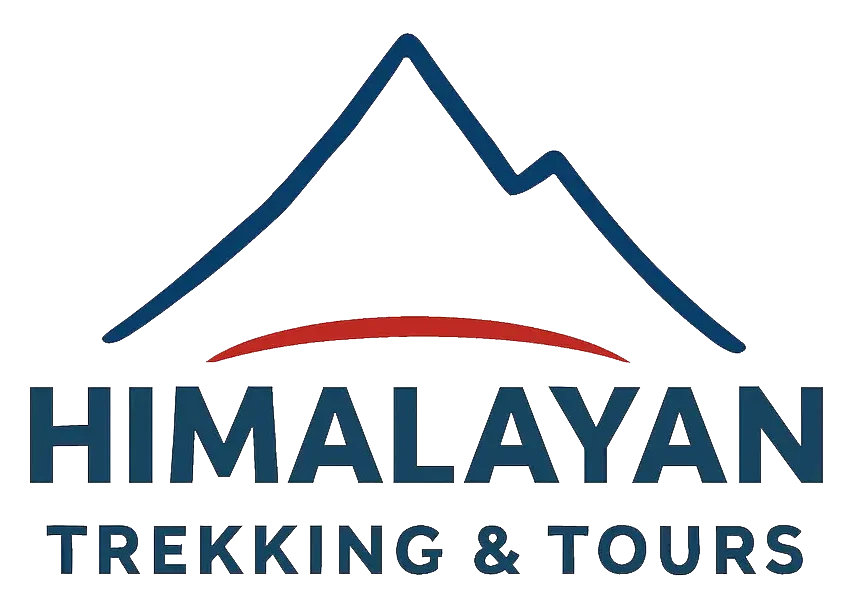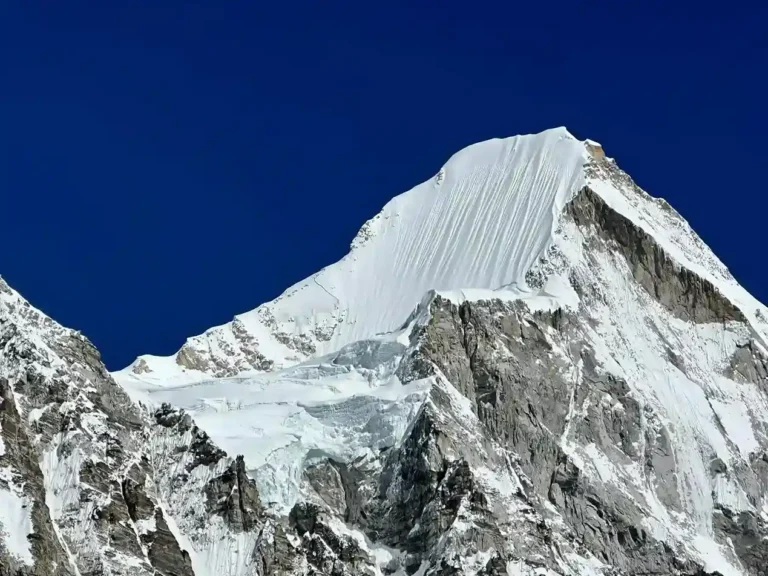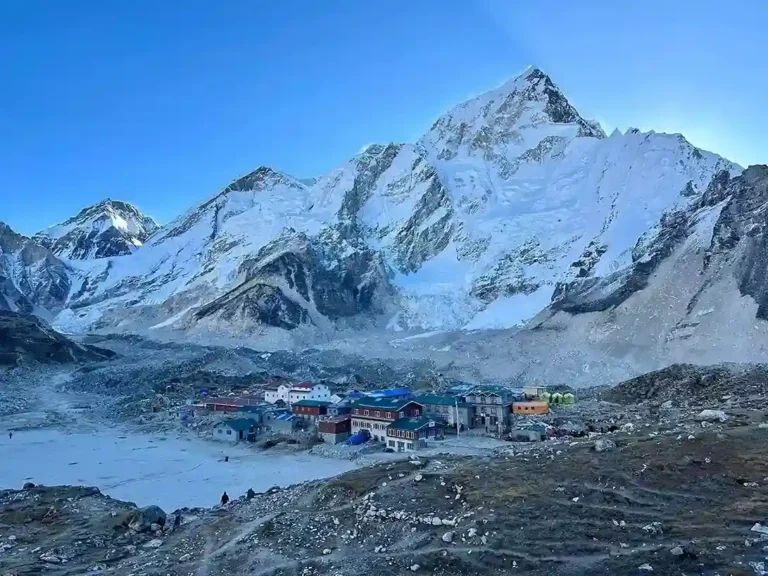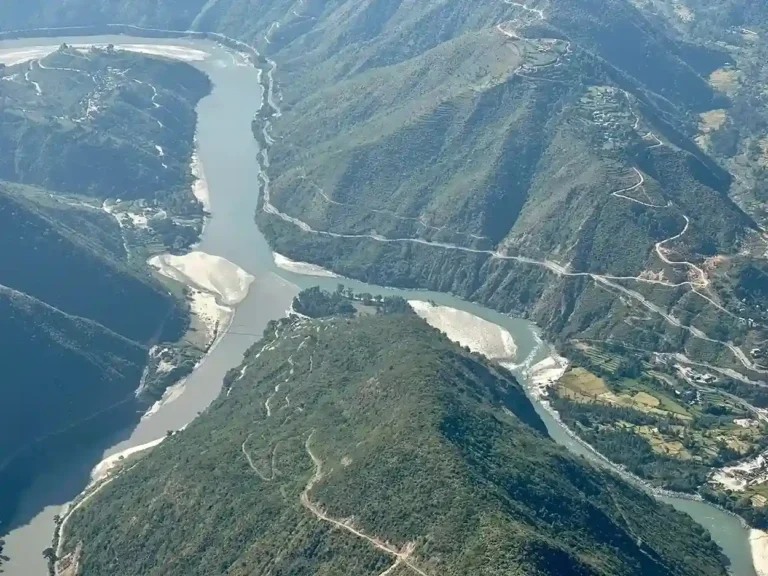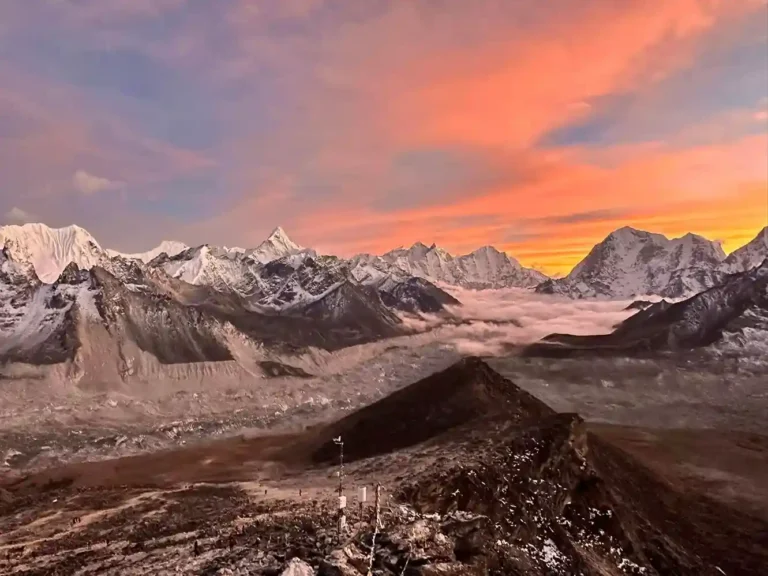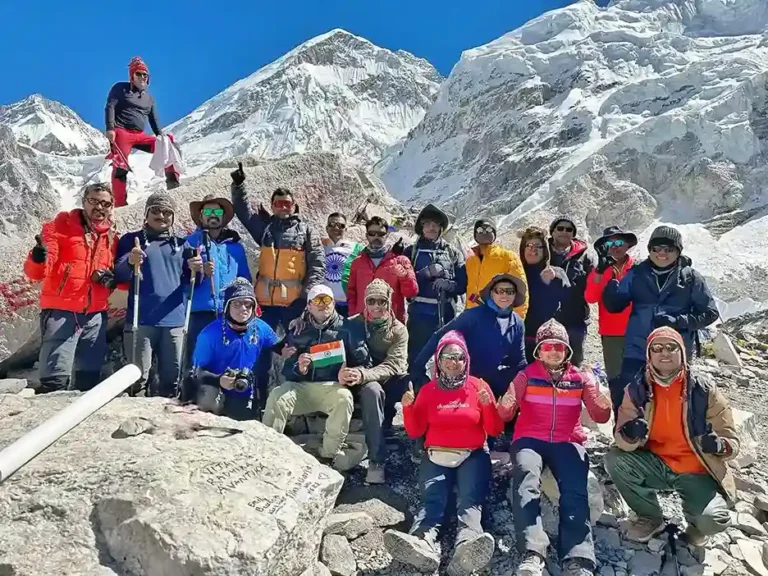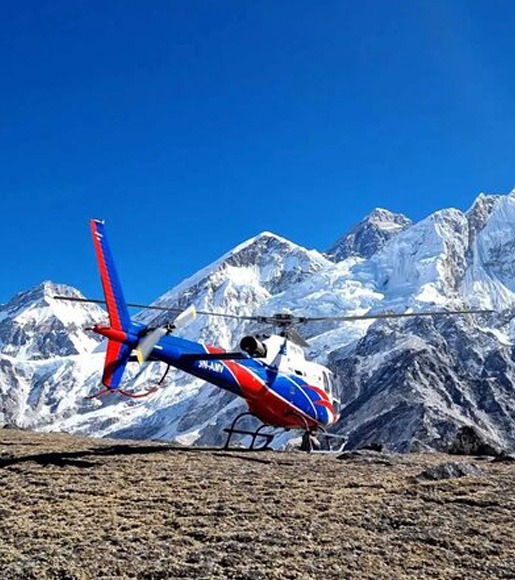Everest Base Camp Trek
-

Trip Duration 14 Days
-

Max, Altitude 5545m
-

Type Standard
-

Best Season Sept - May
-

Meals Included
-

Accommodation Guest House
-

Activity Trekking
-

Difficulty Strenuous
- You will start the trek with an adventurous flight from Kathmandu to Lukla to one of the world’s famous risky airstrips surrounding the great Himalayas.
- Explore Namche Bazaar, a town full of energy and Sherpa famous for its local markets, culture, and scenic mountain views.
- Visit the sacred Tengboche Monastery, a religious and historical place, to observe stunning views of the peaks, including Everest, Ama Dablam and other mountain ranges.
- Witness the most rewarding sights, such as Mount Everest, Lhotse, Nuptse, Ama Dablam, and many other snowy mountains, during the trek.
- A painfully beautiful place to stand is the Everest Base Camp (5,364m); it is the starting point for climbers aspiring to conquer the tallest mountain in the world.
- Trek to Kala Patthar (5545m) to witness the finest sunrise over Everest and its surrounding peaks, which is a memorable experience.
- Meet the local Sherpas, discover their culture, and be treated to their hospitality and locally made yummy foods.
- Cross exhilarating suspension bridges decorated with colourful prayer flags, offering thrilling moments over deep gorges and glacial rivers.
- Trek through the core area of the UNESCO Global Heritage Site, Sagarmatha National Park; experience flora and fauna.
- Stay in cozy teahouses and eat delicious meals accompanied by local hosts, after which you will have a comfortable night with excellent rest after a day’s trekking.
The Everest Base Camp Trek is one of the most adventurous and spectacular treks that interests explorers and trekkers worldwide.
This amazing trail takes you through the Khumbu region of Nepal, allowing you to stand at the base of the highest point on the earth’s surface, Mount Everest (8,848.86m).
Everest Base Camp Trek Overview
The Everest Base Camp Trek starts with a thrilling flight to Lukla and then moves up through various beautiful Sherpa settlements, including Namche Bazaar, Tengboche, and Dingboche. En route, incredible mountains like Ama Dablam, Lhotse, Nupse, and Everest welcome the trekkers.
Besides the natural beauty, the trek also offers a closer look at the life of Sherpas, with opportunities to visit monasteries, see prayer flags, see praying wheels, and enjoy a friendly welcome amongst the local inhabitants in teahouses.
The highlight is reaching the Everest Base Camp at 5,364 m, where climbers begin preparing to attempt Mount Everest. The base camp is even closer and offers the most breathtaking views of Everest and surrounding peaks like Kala Patthar (5,545m).
The trekking is relatively moderate, with steep heights at some points. It demands good health, fitness, and mental stamina to handle many hours of hiking. Usually, it takes between 12 and 14 days, with stops for acclimatization, security, and a comfortable stay.
Trekking seasons include the early autumn and spring; those weather conditions offer a clear troposphere and stable weather.
The Everest Base Camp trek is not only a trek but also a life-altering experience. It involves exploring hostile geography, exposure to the giants of the Himalayas, and rich Nepalese culture.
How difficult is the Everest Base Camp Trek?
Trekking to Everest Base Camp (EBC) is moderately difficult, requiring both physical strength and mental fortitude.
Everest Base Camp trekking involves 12-14 days of walking (about 130 km (80 miles)). Daily treks are 5-8 hours long, with strenuous ascends, descends, rocky surfaces, and rough surfaces.
Altitude is the major limiting factor, with trekkers reaching 5364 m at Everest Base Camp and 5545 m at Kala Patthar. Acclimatization, with regular rest days in locations like Namche Bazaar and Dingboche, significantly prevents altitude sickness.
The oxygen levels at these altitudes are lower, making breathing more difficult and increasing fatigue. Everest Base Camp weather conditions can also make it difficult.
Temperatures at EBC can fluctuate dramatically at night and with weather fluctuations. Therefore, appropriate clothing and equipment are important for cold conditions.
Mental toughness is as important as physical fitness. The trek requires tenacity and endurance, particularly on longer, more arduous days.
However, with enough preparation, reasonable physical fitness and a positive mindset, the Everest Base Camp trek is achievable and very satisfying for those who achieve this incredible feat.
Short Itinerary
Itinerary of Everest Base Camp Trek
Upon arriving at Tribhuvan International Airport in Kathmandu, our dedicated team will greet you warmly. You will be transferred to your hotel in the heart of Thamel.
It is a vibrant district known for its unique blend of restaurants, shops, and local culture.
- 3 star hotel
- Dinner Included
Our journey starts with a scenic flight to Lukla. We will meet the rest of the team and begin our trek there. We descend towards the Cheplung village.
At Cheplung, we get to see beautiful views of Mt. Khumbila. Mount Khumbila (5761m) also known as “God of Khumbu” sacred mountain which has never been climbed. Our journey then continues towards Phakding. Overnight in Phakding.
- Local Guest house
- Breakfast, Lunch and Dinner Included
The first part of the trail is easy. We cross Dudkoshi and walk west of the river, passing through pine forests and small villages.
We continue north of the Benkar Valley, cross the Dudh Koshi again and continue forward, passing through the Chumoa and Monjo villages.
Once we reach Jorsalle, we verify our permits. Here, you will start seeing more sights of the snow-clad mountains ahead. The last parts of the trek get tougher as we must climb a steep incline to reach the Hillary Bridge.
Then, continue hiking up a steep path leading up to Namche Bazaar. Overnight in Namche Bazaar.
- Guest House
- Breakfast, Lunch and Dinner Included
This day is primarily meant for an acclimatization trek to a higher altitude and then back to Namche to sleep one more night at the current altitude. We will be hiking up to Khumjung village. It is a small but vibrant Sherpa village.
We will be visiting the Hillary School and the Khumjung Gompa, where the monastery claims to have a Yeti scalp on display. After our day of exploration, we return to Namche Bazaar. Overnight in Namche Bazaar.
- Guest House
- Breakfast, Lunch and Dinner Included
After breakfast, we trek to the renowned Tengboche monastery in Tengboche village. It is the largest and most significant monastery in the region.
The monastery is perched in a beautiful spot on a high ridge with Mount Ama Dablam in the background. It is surrounded by pines, azaleas and colourful mountain rhododendrons, and the views are just fantastic; you can get good views of Mt. Everest, Nuptse, Lhotse, Ama Dablam, and Thamserku!
Overnight in Tengboche.
- Guest House
- Breakfast. Lunch and Dinner Included
The trail to Dingboche promises outstanding views of the mountains and an excellent experience, as many claim. The first part of the trail is relatively moderate, with river crossings along wooden bridges, climbing up large steps through colourful gateways, and the ever-existing views of the Himalayas.
The climb to Dingboche begins once we reach the Imja Valley and the Lobuche River. The trek to Dingboche is as picturesque as the village itself. Overnight at Dingboche.
- Guest House
- Breakfast. Lunch and Dinner Included
Today, we will go hiking around Dinboche. We shall ascent a ridge behind the village, from where we can get views of six of the tallest mountains in the world, including the Lhotse, Makalu and Cho Oyu, Cholatse, Taboche peak, and other snow-clad mountains rising above the Khumbu Khola Valley, particularly Lobuche West, Lobuche East and Lhotse.
The spot also offers spectacular views of the Imja Khola Valley and the attractive Dingboche village. Overnight at Dingboche.
- Guest House
- Breakfast. Lunch and Dinner Included
We continue on the trail along the lateral moraine of the Khumbu Glacier and pass by stone memorials for climbers who perished in the mountains.
We ascent further as we move towards the Lobuche village which is nestled under the massive Lobuche peak. Overnight at a guesthouse.
- Guest House
- Breakfast. Lunch and Dinner Included
The trail to Gorak Shep is rocky, and when paired with the elevation, it is much tougher. Nonetheless, on Gorak Shep, you feel like you’re walking on a beach because Gorak Shep is a frozen lakebed covered with sand.
Once Gorak Shep is conquered, it is part of the journey you have been waiting for at Everest Base Camp! The trail to EBC is also very rocky and is filled with larger rocks as we move closer towards EBC.
The rocky terrain, the ascents and descents on a glacial path, and the elevation make this trail challenging. However, the views from there and the feeling of being there away from the “world” are incredible.
It isn’t more about the views, but it’s more about the personal sense of achievement you get and realizing that you’ve made it!
You can see the mighty Khumbu Icefall, the upper part of the Khumbu glacier, stunning views of Nuptse, Khumbuste and Pumori, and many other Himalayan giants from EBC. We will head back to spend the night in Gorak Shep. Overnight in Gorak Shep.
- Guest House
- Breakfast. Lunch and Dinner Included
The trek starts early in the morning. We walk up a slope admiring great views of Lingtren, Khumbutse, and Changtse mountains to reach Kala Patthar, a famous landmark in the region; it means black rock.
Some would say Kala Patthar is the highlight of the whole trip. The top of Kala Patthar offers the best views of Mount Everest. Hikers walk early in the morning to Kala Patthar to witness the sunrise from Kala Pattar.
After spending some time at Kala Pathhar, we head back down to Gorak Shep and down to Pheriche. Pheriche is a small Sherpa village made popular by the Tshola Tsho Lake. Overnight in Pheriche.
- Guest House
- Breakfast. Lunch and Dinner Included
Now that we’re done with all the climbing, it’s time to come down. And, by down, 2,000 feet down! We descend through rhododendron, juniper and pine forests, at one point crossing over the Dudh Koshi over a wooden bridge.
We make it down we will see awesome vistas of Ama Dablam, Thamserku and Nuptse mountains await. Twisting and turning through the woods, we finally make it to Namche Bazaar.
Overnight in Namche Bazaar.
- Guest House
- Breakfast. Lunch and Dinner Included
It’s again all downhill from here. Enjoy the views and reflect upon what you achieved these last two weeks. It is a wonderful time to look back at the entire journey fully.
After passing some rocky paths, it is just a quick descent, crossing several suspension bridges until we reach our destination. We will also be passing by many monasteries, too.
And finally, we make it back to Lukla. This will be the last day in the mountains! Time to rest, reflect and relax! Overnight in Lukla.
- Guest House
- Breakfast. Lunch and Dinner Included
We will catch an early morning flight to Kathmandu, where we can do some last-minute souvenir shopping and some celebration! You can also check out some other places in Kathmandu, we will be assisting you with that as well.
A farewell dinner is arranged to celebrate your success. Overnight in Kathmandu.
- 3 Star hotel
- Breakfast. Lunch and Dinner Included
This is it, your last day in Nepal. It’s time to say goodbye, but we hope we’ll meet again! Our representative will escort you to the airport three hours before the scheduled flight.
- Breakfast Included
Lukla Flight Information
The weather conditions in the mountain region of Nepal can change rapidly, and aviation schedules are not as reliable as you might expect.
The flight between Ramechhap/Manthali and Lukla is frequently delayed and may be cancelled for the day or several days. If your flight is cancelled, we will rebook your flight for the following day.
You should apportion one or two extra days if your flight gets cancelled and you are short of scheduled time.
Price includes
- Kathmandu Airport – Hotel – Airport transfer by Private vehicle
- Three Meals (Breakfast, Lunch and Dinner) during the trek
- Tea and Coffee during the trek
- Twin Sharing Accommodation at Kathmandu at 3 star hotel with breakfast
- Twin sharing accommodation during the trek
- National Park Entry Fee, Local Government Entry fee
- Domestic Flight from Kathmandu/Ramechhap to Lukla and Return
- 1 Experienced guide for the group of 2 to 10 and assistant guide for a group above 10
- One porter assigned for two people to carry luggage
- Our Staff’s daily meal, wage, equipment, insurance and allowances
- First aid kit with high-altitude medicines
- Duffel bag and Sleeping bag (Must be returned after completion of the trek)
- Trek completion certificate (Upon request)
- Our Service Charges
Price Excludes
- International airfare, Nepal Visa and travel insurance
- Meals in Kathmandu except breakfast
- Extra night accommodation in Kathmandu ( early arrival or flight cancellation etc)
- Personal expenses such as shopping, Laundry, Internet, Phone call etc
- Drinking water, cold drinks and alcohol drinks
- Gratuities for staff
Have any Questions? Check out FAQ'S
Trip Essential Information
Altitude Sickness in Everest Base Camp Trek
The main health risk trekkers face during the EBC trek is Acute Mountain Sickness (AMS). Altitude sickness is caused by inhaling thin air at high altitudes. When you get to altitudes of 2,500 meters and beyond, you are more vulnerable to AMS, and if you rush to ascend quickly without proper acclimatization, you probably get AMS.
The symptoms of acute mountain sickness in EBC Trek include headaches, nausea and vomiting, dizziness, fatigue, loss of appetite, and difficulty sleeping. HAPE may cause pulmonary hypertension and heart failure, whereas HACE leads to cerebral oedema and jeopardises the lives of affected individuals.
Several precautions for altitude sickness can be taken to avoid such an experience. These include gradual ascents in the altitudes. Acclimatizing days, such as Namche Bazaar and Dingboche, are important before the trip. Also, stay hydrated, eat nutritious meals, and avoid alcohol or smoking if possible.
Symptoms of AMS will require rest and hydration and not continue with the climb to higher altitudes. If the symptoms worsen, which is rare, the best treatment is to go down to a lower altitude at once. Most trekkers can complete the EBC trek while enjoying the full journey.
Food During Everest Base Camp Trek
The food on the Everest Base Camp trek is plain, wholesome, and calculated to give trekkers enough energy.
Food is available at teahouses along the way and varies from simple to fancy; however, as you climb higher, the food and service may be simpler and more expensive.
Breakfast commonly consists of Tibetan bread, pancakes, porridge, eggs, muesli, and beverages like tea, coffee, and hot chocolate. It is usually Continental or English, while the staple Nepali meal is Dal Bhat Tarkari.
Others are fried rice and noodles, dumplings (momos), potatoes, soups, and some simple Western dishes such as spaghetti, chow mein, pizzas, etc.
Everest Base Camp Trek Accommodation
There are few tourist-standard lodges at the Everest Base Camp Trek, and most accommodations are tea houses that provide beds, food, and rest.
These teahouses are located along the Everest Base Camp Trek trail in Lukla, Namche Bazaar, Tengboche, and Dingboche. They offer trekkers a chance to relax after several hours of trekking.
The rooms are very basic, with amenities such as a bed, a blanket, and a pillow. The rooms might be much colder depending on where the place is situated in the mountains. Therefore, you will need extra blankets or a sleeping bag.
Rooms may be slightly more comfortable at lower altitudes as the trail advances towards the higher zones. Still, accommodations become more basic because transporting supplies to the top is an ordeal.
The teahouses provide shared dining rooms where tourists can eat hot food and converse with other tourists. The price depends on the level of service, and most accommodations include meals; however, the price goes up with altitude and if the accommodation is in the wilderness.
In higher altitudes such as Gorakshep, the lodging is limited to small lodges; staying in such lodges also makes the trekking even more exciting. Although the place is quite basic, the comforts of the accommodation are perfect for one to rest and recharge before going on with the tour.
A Typical Day Everest Base Camp Trek
Each day on the Everest Base Camp trek begins early, around 6:00 AM, with trekkers preparing for the day’s hike.
After a hot drink like tea or coffee, breakfast is usually around 7:00 a.m. and consists of Tibetan bread, porridge, or eggs. Depending on the trail chosen and its difficulty, the trek usually starts between 7:30 and 8 a.m.; trekkers walk for about 5 to 8 hours daily.
The trail again involves some inclines, steep slopes and rocky. Small intervals are made for water intake and snacks so people can relax and view the mountains. Lunch is normally between 12:00 P.M. – 1:00 P.M., enjoying the Nepali organic foods and mountain view.
Continued by the afternoon trek, the trail progressively gets steeper as the elevation gains. After lunch, the trek continues; the path gets steeper, and the weather gets colder as the elevation rises.
By 3:00-4:00 PM, trekkers reach the next teahouse throughout the daytime, where they can idle and prepare for the night. Trekkers have time to explore and walk around before dinner when getting to the camp.
The tea house has a dining hall where the trekkers eat their daily meals. The remaining time is spent interacting with other trekkers.
Afterwards, around 7 p.m., trekkers head to their rooms to prepare for a good night’s sleep and rest before the next trek.
Everest Base Camp Trek Permits
The EBC Trek requires permits because a variety of structures and guidelines are in place to protect both the physical and social landscape of the areas being visited. Here are the required permits:
1. Gaurishankar Conservation Area Permit (GCAP): Required only if approaching the area through the Jiri-Salleri trail; this permit costs foreign individuals NPR 3,000 with the money used to support the conservation of the region’s biodiversity.
2 . Sagarmatha National Park Permit: This is essential to access Sagarmatha National Park, where EBC is situated. Promoting conservation costs NPR 3000 for foreigners and NPR 1500 for SAARC nationals.
3. Khumbu Pasang Lhamu Rural Municipality Permit: This permit, which costs US$20, has reportedly been introduced to phase out TIMS in the Everest region. However, the authorities aim to use it to foster local development and tourism management.
These permits support conservation, infrastructure development, and community welfare and guarantee safe trekking adventures.
EBC Trek Travel Insurance
It is highly advised that travellers take out insurance to guard against some of these occurrences when on an EBC trek.
When travelling to high altitudes, one is at risk of altitude sickness, injury, or getting struck by issues such as bad weather, and insurance covers such situations. Some areas that must be covered include health-related expenses, evacuation costs, trip cancellations, and lost luggage.
Health insurance is paramount since access to a doctor by road is difficult in some desolate territories. Even if they are flown to a camp, flying a helicopter is extremely expensive. Check that the insurance will permit high altitudes of 5,500 meters, as several usual insurance policies may not allow this.
Also, coverage for trip delays or cancellations is essential in case they occur while on the itinerary. Remember to bring a copy of the insurance policy and emergency contact number. Though not compulsory, having travel insurance helps ease the mind and makes the trekking expedition safer.
Everest Base Camp Trek Cost
The Everest Base Camp Trek costs USD 1450 to 1850 per person. It is an easy, comfortable, and all-inclusive trek.
This Everest Base Camp Trek cost includes all the required permits, round-trip domestic flight tickets between Kathmandu and Lukla, full-board meals and lodgings, and the professional services of an experienced guide and porter. Further, the insured package also includes airport transfers, first aid facilities, and pre-trek briefings.
To this end, our fully inclusive itinerary means that you will not have to bother about the details of this wondrous area of the Everest region — you will be free to laugh and wonder at the spectacular sights.
For experienced first-time trekkers, the EBC trek offers the highest standards of comfort, safety, and customer service, so every step towards exhilaration is one less worry. We invite you to trek with us for a safe and unforgettable adventure to Everest Base Camp!
Best Time for Everest Base Camp Trek
The best time to visit EBC is from March to May and September to November. These months have a good climate without precipitation and suitable temperature conditions. Spring is relatively warm, with many wildflowers on the trees and the ground, making it a good season for a trek.
It is also the season when many climbers try to get to the base of Mount Everest, thus making the trail very cheerful. Another best time for Everest Base Camp Trek is autumn, which has weather comparable to spring, with cool temperatures and clear skies, thus becoming more suited for the trek.
During this season, it is very dry, making trail hiking much easier. The views over the mountains are spectacular. Because the trekking grounds are wet and slippery, it is advised not to venture into trekking when the monsoons peak from June to August.
Winter from December to February because of cold weather makes the trek challenging.
Drinking Water in EBC Route
Water is essential on the Everest Base Camp trek because water is crucial in high-altitude regions. That means that although bottled water can be purchased at various teahouses along the way, it can be very expensive, especially when one reaches a higher altitude.
To avoid expenses and the use of plastics, it is suggested that people have personal reusable bottles of water purification tablets and portable water filters. Most teahouses that sell food and beverages serve boiled water, and you can purchase a refill for your water bottle at a small charge.
Water is scarce at some higher altitudes, and water storage must be protected from freezing. Do not drink water from a stream or river that has not been boiled or treated, as it may contain bacteria. Taking water or purifying methods with you will guarantee a supply of purified water during your trek.
WIFI, Electricity And Communication in Everest Base Camp Trek
Almost all Everest Base Camp trek teahouses provide Wi-Fi, though service quality and speed can vary greatly when ascending higher altitudes.
There is a chance that even in the lower villages like Lukla and Namche Bazaar, the internet connection is slightly better, but overall, beyond this place, it gets terrible. Internet, for the most part, is extra and by tariff, meaning that the higher you go, the more you are charged.
As we know, it is great for communication with the family or getting some information, but it is not quite suitable for intensive browsing or streaming.
Electricity in Everest Trek is available in the teahouses in the Everest region, though it is unpredictable, particularly where each teahouse is far apart. Teahouses depend on solar power or small generators, mostly for lighting.
Hence, the electricity supply is usually restricted for a few hours, preferably at night. You may be charged for recharging your devices and are advised to carry power banks to ensure your battery is charged throughout the day.
Phone interaction exists in many regions throughout the trek, especially in lower-altitude villages such as Namche Bazaar and Lukla. Only two mobile operators are available in Nepal, including Nepal Telecom and Ncell, which have 3G signals in most places.
However, as you go higher in altitude, the signal strength is low, or there is little or no signal. Teahouses provide satellite phones that clients can use during emergencies, although these phones are limited.
MAP
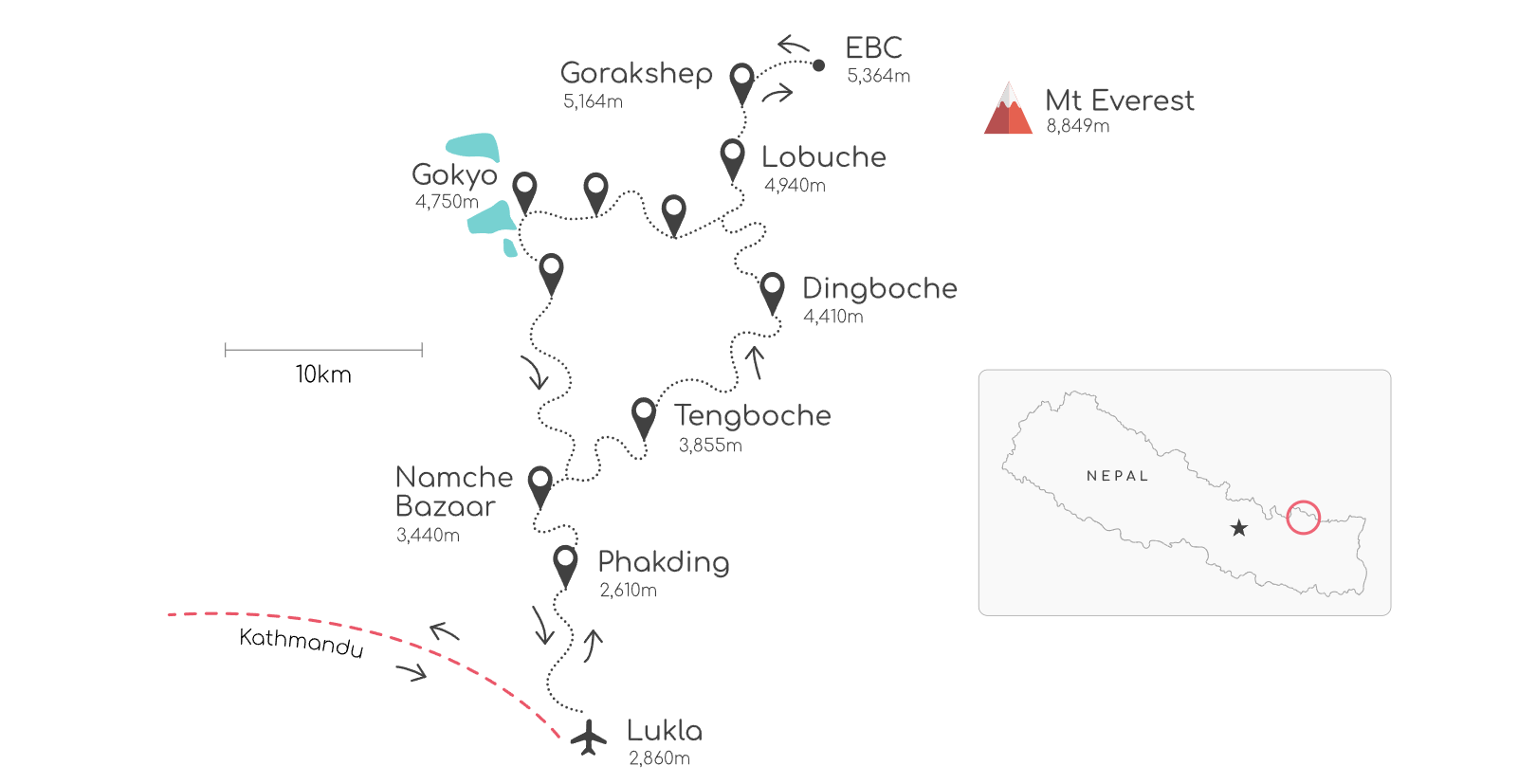
Frequently Asked Questions (FAQ)
Trekking to Everest Base Camp’s difficulty varies based on your fitness, trekking background, and altitude adaptation. The journey includes tough uphill and downhill paths, rough terrain, and changeable weather. Altitude is vital, and altitude sickness is a concern. With good preparation, training, and expert guidance, most moderately fit individuals can accomplish the trek.
The Everest Base Camp trek takes about 12 to 14 days, including arrival and departure days. This gives time for adjusting to the high altitudes and resting, which is very important.
The cost of the Everest Base Camp Trek can vary widely due to factors like your chosen trekking company, service level, accommodation preferences, trekking season, and any added activities.
On average, the cost can range from $1,000 to $1,800 USD or more per person. This generally includes permits, guides, porters, lodging, meals, flights, and essentials. It’s best to do research and pick a reliable trekking company that suits your budget and preferences.
Even if you’re new to trekking, as long as you’re reasonably fit and determined, you can make the Everest Base Camp trek. Being well-prepared physically and mentally is key. The altitude, steep trails, and changing weather might challenge newcomers.
Picking an experienced trekking company with adept guides, enough acclimatization time, and a fitting itinerary significantly boosts beginners’ trekking success. Always consult medical experts and trek organizers before setting off.
To secure the Sagarmatha National Park Permit, you have a couple of options. You can visit the Nepal Tourism Board Office located at Pradarshani Marg, Kathmandu. Their official website is https://ntb.gov.np/ for further information. Or we can help you to get permit if you book this trip with us.
Entry Fees for Sagarmatha National Park for Foreign visitors: NPR 3,000 per person, and for SAARC nationals: NPR 1,500 per person. For Children under 10: Free entry You will need your passport with you to get this permit.
Yes, When heading on the Everest Base Camp Trek, it’s essential to obtain permits. Permits are a requirement for all national parks in Nepal, including the Sagarmatha National Park.
The Everest Base Camp trek has different local and international flavours. It thus caters to various tastes. While the options might be limited compared to urban areas, the quality and variety are surprisingly good. Here’s what you can expect:
Local Delicacies
- Dal Bhat: This is a regular Nepalese meal. It comprises lentil soup, rice, and various vegetable or meat curries. It is a very hearty and nutritious option, providing great energy for trekking.
- Momos: These steamed or fried dumplings filled with meat or vegetables are a popular street food and are loved by many. It is a very convenient snack on the trail.
- Thukpa: A Tibetan noodle soup that is served with vegetables or meat. Thukpa is a warming and comforting meal, especially during colder days.
- Yak Cheese: This cheese is a local delicacy made from yak milk. It is enjoyed as a snack or incorporated into various dishes.
International Fare
- Continental Options: Many tea houses provide Western-style dishes like pasta, pizza, and sandwiches to serve to international trekkers.
- Vegetarian and Vegan: Many vegetarian and vegan options are available, including curries, soups, and stir-fries.
- Snacks: You will find many snack options, such as chips, biscuits, and chocolate, available at tea houses and shops along the trail.
Factors Affecting Food Availability
- Altitude: As you gain altitude, the variety and quality of food options may decrease. Higher-altitude tea houses often have more limited menus.
- Seasonality: The availability of certain ingredients can vary depending on the season. For example, fresh fruits and vegetables may be more limited during the off-peak trekking season.
- Tea House: The specific tea house you’re staying at will determine the available food options. Some tea houses specialize in local cuisine, while others offer a wider range of international dishes.
Packaging snacks and energy bars for convenience is advisable, especially during long trekking days. Additionally, carrying a water purification system or purchasing bottled water from reputable sources is a good idea to ensure safe drinking.
The EBC trek is considered moderately challenging. It demand physical fitness and mental fortitude. The main challenges you’ll face are:
- High Altitude: The trek reaches altitudes of over 18,000 feet, which can cause altitude sickness if not acclimatized properly.
- Long Days: You will be hiking for several hours each day, often on uneven terrain.
- Cold Weather: Temperatures can be cold, especially at higher altitudes.
No, you cannot go to Everest Base Camp alone. The Nepalese government has imposed a ban on solo trekking in the country, effective from April. This ban is in place to ensure the safety and well-being of trekkers and to prevent accidents.
To trek to Everest Base Camp, you must be accompanied by a registered trekking company or guide. This will provide you with necessary support, assistance, and expertise throughout your journey.
The success rate for the Everest Base Camp trek is generally high, estimated to be around 95-96%. This is due to several factors:
- Improved infrastructure: Better trails, accommodations, and medical facilities have made the trek safer and more accessible.
- Experienced guides: Professional guides are well-versed in handling high-altitude conditions and ensuring the safety of trekkers.
- Acclimatization: Proper acclimatization schedules help to minimize the risk of altitude sickness.
- Advance planning: Many trekkers are well-prepared with appropriate gear, training, and knowledge of the trek.
However, it is very important to note that the trek still poses risks, such as altitude sickness, weather conditions, and personal health issues. Proper preparation, including physical fitness, acclimatization, and following the advice of experienced guides, is important for a successful and safe trek.
- Instant Confirmation
- Free to customize
- Support anytime
© 2025 - Himalayan Trekking and Tours (P) Ltd. All Rights Reserved.
